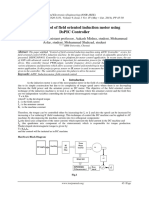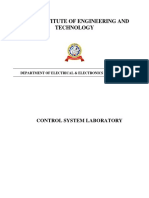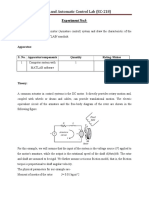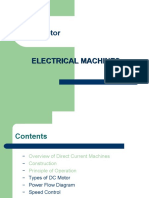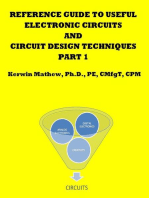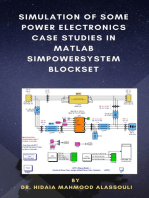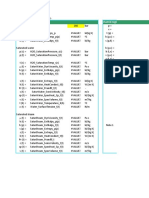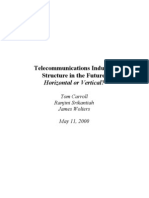Lab Project
Lab Project
Uploaded by
devakisvaniCopyright:
Available Formats
Lab Project
Lab Project
Uploaded by
devakisvaniCopyright
Available Formats
Share this document
Did you find this document useful?
Is this content inappropriate?
Copyright:
Available Formats
Lab Project
Lab Project
Uploaded by
devakisvaniCopyright:
Available Formats
Project Simulation of Induction Motor Drives
Objectives
To investigate characteristics of two induction motor speed control systems.
Part A: Induction motor v/f speed control using square wave operation
A.1 Model Building Build the Simulink model according to the block diagram shown in Fig. 1. You may use some of the models you built in the previous lab sessions. The parameters of the induction motor speed control system are as follows.
Induction motor DC link resistor Low pass filter
Power Supply Load torque Other constants
Nameplate data: 3, 3hp, 220V, 8.4A (rated) and 1710rpm. Use the motor parameters given in Table 4.10-1, P165, textbook. Add a resistor in the dc link. This resistor represents the power loss of the SCR rectifier and dc link bus. The equivalent resistance is 0.5. This is a second order lower pass filter with dc gain k = 1 and quality factor Q = 1. The corner frequency of the filter should be the same as the reference frequency of the drive. The LP filter is used to extract the fundamental component from the square wave output voltage Van. 60Hz, 127V per phase. 12.5N.m (rated torque) Kv = 0.95/60 and Vcomp = 0.
Mux Vdc Vdc Van
Vqs iqs
Va 3 phase Vb Vc Vdo AC Supply t_d acos fcn included V_alpha 3-phase Square Wave Generator 0.05 Vcomp Kv SCR Rectifier Firing Circuit Sc Vcn Three Phase VSI Filter Sa DC Link Sb VS I
3-phase To 2-phase
Vds ids
2-phase To 3-phase
Ia
Vbn 12.5 Load Torque [N.m]
W Wr m Tl Te
2-3 Transform
Te 60/(2*pi) Gain Induction motor model in the arbitrary frame n
0 Stator fixed Frame
Sum
LP Filter (2nd Order) Van 60
Van1
Ref [Hz]
Fig. 1. Induction motor v/f speed control system using square wave operation.
Advanced Electromechanical Systems
ELE 847
A.2 Simulation tasks 1) Run the Simulink model and determine the value of the dc link capacitor such that the dc link voltage ripple is limited to 10% when the inverter operates at 20Hz with a rated V/f and the motor operates with rated torque. Plot the steady state waveforms of vdo and vdc (e.g., 2 cycles of the supply frequency). 2) Start the drive system until a steady state operation is reached. Complete the following table. Inverter Output Frequency [Hz] 60 45 30 15 5
Van (Fundamental, peak, steady state)
Van (Fundamental, rms) V / f Ratio (Volts,rms/Hz) Steady State Speed n (rpm) Synchronous Speed ns (rpm) Slip Speed (ns - n) 3) To compensate the voltage drop on stator winding resistance at low frequencies, let Kv = 0.9/60 and Vcomp = 0.05. Run the drive system and complete the following table. Inverter Output Frequency [Hz] 60 45 30 15 5
Van (Fundamental, peak, steady state)
Van (Fundamental, rms) V / f Ratio (Volts,rms/Hz) Steady State Speed n (rpm) Synchronous Speed ns (rpm) Slip Speed (ns - n) 4) Start the drive system at 60Hz under the operating conditions given in 2) until a steady state operation is reached. Plot the transient waveforms of motor speed n, stator current Ia, motor torque Te, diode rectifier output voltage Vdo and inverter input voltage Vdc. 5) Since you are not using a ramp limiter to soften the rate in which the reference frequency is applied, how does this affect your initial current and torque?
Advanced Electromechanical Systems
ELE 847
Part B. Induction motor v/f speed control using PWM.
B.1 Model Building Build the Simulink model shown in Figure 2. The system parameters remain the same as those given in Part A. B.2 Simulation tasks Repeat the simulation tasks specified in A.2-2.
Fig. 2. Induction motor v/f speed control using PWM Inverter.
Report The formal report should include the following items: 1) Cover page (including project title, your name, student ID, date) 2) Abstract (a paragraph of about 200 words) 3) Theory (two full pages, 1.5 line space) 4) All required waveforms, tables and calculations 5) Comment on the size of the dc link capacitors used in both systems 6) Compare the simulation results obtained in Part A.2-2 and A.2-3 by answering the following questions:
Advanced Electromechanical Systems 3 ELE 847
7) 8) 9) 10)
- Is the V/f ratio constant? You may draw V versus f curves for comparison. - Is the slip speed constant? Why? Compare the simulation results obtained in Part A.2-2 and B.2 Comments on harmonic issues of the two systems Conclusions (300 400 words) Appendix: Simulink model in Part B including block diagrams of all subsystems.
Advanced Electromechanical Systems
ELE 847
You might also like
- DC MotorDocument6 pagesDC MotorKumaran SgNo ratings yet
- Hispeed Dual Theory of OperationDocument139 pagesHispeed Dual Theory of OperationJoel Inacio100% (3)
- Bosch Servodyn InverterDocument38 pagesBosch Servodyn Invertermeanbrake100% (2)
- rr410202 Power Semi Conductor DrivesDocument8 pagesrr410202 Power Semi Conductor DrivesSrinivasa Rao GNo ratings yet
- GP FileDocument14 pagesGP FileVikri RahmatNo ratings yet
- H09344550 PDFDocument6 pagesH09344550 PDFkavyaNo ratings yet
- Design and Implementation of IGBT Based Single Phase AC Drive Using PIC 18F452Document4 pagesDesign and Implementation of IGBT Based Single Phase AC Drive Using PIC 18F452lajosmol100% (1)
- Induction MatlabDocument12 pagesInduction Matlabgrido002No ratings yet
- Practice ProblemsDocument4 pagesPractice Problemsdragon_warrior112456804No ratings yet
- Synchronous MachineDocument51 pagesSynchronous MachineahmmsayemNo ratings yet
- PID Practical PDFDocument18 pagesPID Practical PDFJose Luis HurtadoNo ratings yet
- EE211 Exam S1-09Document8 pagesEE211 Exam S1-09abadialshry_53No ratings yet
- DSP-Based Experimental Rig With The Doubly-Fed Induction Generator ForDocument12 pagesDSP-Based Experimental Rig With The Doubly-Fed Induction Generator Fordebasis250No ratings yet
- Modelling File Edited AnuragDocument53 pagesModelling File Edited AnuragHARENDRA BHINCHARNo ratings yet
- DC Motor Speed Control System - ED4400BDocument14 pagesDC Motor Speed Control System - ED4400BDanang Pradika Purnomo100% (1)
- DC Machine DriveDocument15 pagesDC Machine DriveMridul MishraNo ratings yet
- Ee2257 LMDocument104 pagesEe2257 LMthamizmaniNo ratings yet
- v42 63Document5 pagesv42 63Bala KumarNo ratings yet
- Chapter 1 DC Drives Part2Document75 pagesChapter 1 DC Drives Part2Mohammad MunzirNo ratings yet
- ELEC4160 Exam 2009 - CompleteDocument8 pagesELEC4160 Exam 2009 - Completesiang8No ratings yet
- NR 410202 Power Semiconductor DrivesDocument8 pagesNR 410202 Power Semiconductor DrivesSrinivasa Rao GNo ratings yet
- Control Systems Lab ManualDocument67 pagesControl Systems Lab ManualRockstar Rich100% (1)
- Final See4433 201112-1Document9 pagesFinal See4433 201112-1no_rules_guysNo ratings yet
- Vector Control of AC Motor Drive For Active Damping of Output Using Passive Filter ResonanceDocument6 pagesVector Control of AC Motor Drive For Active Damping of Output Using Passive Filter ResonanceijaertNo ratings yet
- Kontrola Brzine DC Motora Pomoću TiristoraDocument6 pagesKontrola Brzine DC Motora Pomoću TiristoraTHOMPSONvkNo ratings yet
- 136052104-Mt-Power Electronic Control of DC DrivesDocument2 pages136052104-Mt-Power Electronic Control of DC DrivesNavneetha PeramoniNo ratings yet
- ASSIGNMENT Elektric q1-q3Document16 pagesASSIGNMENT Elektric q1-q3Nur Aisyah ZainuddinNo ratings yet
- Simulation and Design of Low Cost Single Phase Solar InverterDocument7 pagesSimulation and Design of Low Cost Single Phase Solar InverterAnjana VaranasiNo ratings yet
- CS7Document8 pagesCS7zubairashrafNo ratings yet
- Current Mode Controller Design For Single Phase Grid Connected Inverter Using Proportional Resonant Control StrategyDocument6 pagesCurrent Mode Controller Design For Single Phase Grid Connected Inverter Using Proportional Resonant Control StrategyijeteeditorNo ratings yet
- DC Motors: 2.0 ObjectivesDocument16 pagesDC Motors: 2.0 ObjectivesBelayet RonyNo ratings yet
- D.C control matlab روكانDocument17 pagesD.C control matlab روكانMustafa AlhumayreNo ratings yet
- User's Manual: D.C. Motor StudyDocument25 pagesUser's Manual: D.C. Motor Studymanoj_varma_1No ratings yet
- Question BankDocument5 pagesQuestion BanklalitaerankiNo ratings yet
- DC Motors Speed Control - ModDocument9 pagesDC Motors Speed Control - ModAnuja VargheseNo ratings yet
- 750V DC Traction SystemDocument26 pages750V DC Traction SystemShashi Bhusan Singh100% (2)
- Speed Control of Three Phase Induction MotorDocument8 pagesSpeed Control of Three Phase Induction MotorsasNo ratings yet
- 52104-mt - Power Electronic Control of DC DrivesDocument2 pages52104-mt - Power Electronic Control of DC DrivesSRINIVASA RAO GANTANo ratings yet
- DC Link Approach To Variable-Speed, Sensorless,: Induction Motor DriveDocument5 pagesDC Link Approach To Variable-Speed, Sensorless,: Induction Motor DrivesamirmansourNo ratings yet
- 3 Phase InverterDocument6 pages3 Phase InverterRitul ShahNo ratings yet
- File ServeDocument8 pagesFile Serveollata kalanoNo ratings yet
- (212142518) Stepper Motor Control Using MicrocontrollerDocument4 pages(212142518) Stepper Motor Control Using MicrocontrollerraghavthakurjiNo ratings yet
- A Variable-Speed, Sensorless, Induction Motor Drive Using DC Link MeasurementsDocument6 pagesA Variable-Speed, Sensorless, Induction Motor Drive Using DC Link Measurementsgowtam_raviNo ratings yet
- P. F Correction Control of 3-Ф Induction Motor Drive through PWM Current Controlled TechniqueDocument6 pagesP. F Correction Control of 3-Ф Induction Motor Drive through PWM Current Controlled TechniqueDivya ShriNo ratings yet
- Electric Power Systems: 1° PartDocument2 pagesElectric Power Systems: 1° Partkirokiro92No ratings yet
- Control System Lab ManualDocument63 pagesControl System Lab ManualkrishnandrkNo ratings yet
- Drives and Control Lab ManualDocument36 pagesDrives and Control Lab ManualKabilanNo ratings yet
- 20 The Essence of ThreePhase INTELEC2011Document28 pages20 The Essence of ThreePhase INTELEC2011noreuNo ratings yet
- EE 392: Control Systems & Their Components: Lab 2: DC Motor Speed: Frequency Domain Methods For Controller DesignDocument4 pagesEE 392: Control Systems & Their Components: Lab 2: DC Motor Speed: Frequency Domain Methods For Controller DesignAbdalla FathyNo ratings yet
- Four-Quadrant Single-Phase Rectifier DC DriveDocument14 pagesFour-Quadrant Single-Phase Rectifier DC DriveBivolaru AndreiNo ratings yet
- BDocument46 pagesBemmanueel2No ratings yet
- System and Automatic Control Lab (EC-218) : Experiment No. 5Document3 pagesSystem and Automatic Control Lab (EC-218) : Experiment No. 5arjunv_14No ratings yet
- DC MotorDocument38 pagesDC MotorasuypowerNo ratings yet
- 12-Pulse Series-Type Diode RectifierDocument8 pages12-Pulse Series-Type Diode RectifierSheetal VermaNo ratings yet
- Text10 PDFDocument19 pagesText10 PDFJosNo ratings yet
- Power System Transient Analysis: Theory and Practice using Simulation Programs (ATP-EMTP)From EverandPower System Transient Analysis: Theory and Practice using Simulation Programs (ATP-EMTP)No ratings yet
- Reference Guide To Useful Electronic Circuits And Circuit Design Techniques - Part 1From EverandReference Guide To Useful Electronic Circuits And Circuit Design Techniques - Part 1Rating: 2.5 out of 5 stars2.5/5 (3)
- Simulation of Some Power System, Control System and Power Electronics Case Studies Using Matlab and PowerWorld SimulatorFrom EverandSimulation of Some Power System, Control System and Power Electronics Case Studies Using Matlab and PowerWorld SimulatorNo ratings yet
- Simulation of Some Power Electronics Case Studies in Matlab Simpowersystem BlocksetFrom EverandSimulation of Some Power Electronics Case Studies in Matlab Simpowersystem BlocksetRating: 2 out of 5 stars2/5 (1)
- Simulation of Some Power Electronics Case Studies in Matlab Simpowersystem BlocksetFrom EverandSimulation of Some Power Electronics Case Studies in Matlab Simpowersystem BlocksetNo ratings yet
- Advanced Control of AC / DC Power Networks: System of Systems Approach Based on Spatio-temporal ScalesFrom EverandAdvanced Control of AC / DC Power Networks: System of Systems Approach Based on Spatio-temporal ScalesNo ratings yet
- Fire Safety of BuildingsDocument55 pagesFire Safety of BuildingsRayanNo ratings yet
- Energy and Exergy Analysis of Thermal Power PlantDocument9 pagesEnergy and Exergy Analysis of Thermal Power PlantKONDURI CHAITANYANo ratings yet
- Radiation Safety ProcedureDocument15 pagesRadiation Safety ProcedureMANDY CROTONNo ratings yet
- DBC-S15-S21 control box.terminal detailDocument1 pageDBC-S15-S21 control box.terminal detailsaman.sanaz6667No ratings yet
- Quick Installation Guide: Wireless N300 Gigabit Cloud Router Dir-636LDocument7 pagesQuick Installation Guide: Wireless N300 Gigabit Cloud Router Dir-636LdjduncanNo ratings yet
- SlinkyDocument14 pagesSlinkypusicantonijeNo ratings yet
- MS 1138-3-2023Document5 pagesMS 1138-3-2023LAVOS100% (1)
- Housing in India: Reinterpreting Habrakens Theories in The Indian ContextDocument17 pagesHousing in India: Reinterpreting Habrakens Theories in The Indian Contextusernaga84No ratings yet
- Flange Fitting Price List March 2013Document13 pagesFlange Fitting Price List March 2013MuhammadNo ratings yet
- L48V6CFDocument16 pagesL48V6CFAndré LuisNo ratings yet
- Structural Analysis of Blast Resistant BuildingsDocument6 pagesStructural Analysis of Blast Resistant BuildingsRahmatullah MawlanyNo ratings yet
- Abb Rtu560cig10 BrochureDocument2 pagesAbb Rtu560cig10 BrochureLeonardo TaffurhtNo ratings yet
- Customer Father-Of: Name Address SSNDocument28 pagesCustomer Father-Of: Name Address SSNMichelle Marzan CaranguianNo ratings yet
- Wireless Application Protocol: 1. A Different MarketDocument6 pagesWireless Application Protocol: 1. A Different Marketdeepu0787No ratings yet
- 4 - Task B-Engine MechanicalDocument4 pages4 - Task B-Engine Mechanicaldarkim ajahNo ratings yet
- Coefficient of Friction RubberDocument13 pagesCoefficient of Friction RubberanilpradeepNo ratings yet
- Koelbel Steps PDFDocument54 pagesKoelbel Steps PDFOnggo Firstha Nichita100% (1)
- Emperical ResearchDocument13 pagesEmperical ResearchABITHANo ratings yet
- Assa Abloy DL6120ST Stepdock - LeafletDocument2 pagesAssa Abloy DL6120ST Stepdock - LeafletmujahaddadNo ratings yet
- Compressor Sizing Using DWSIMDocument21 pagesCompressor Sizing Using DWSIMHassanNo ratings yet
- Solution ArchitectureDocument16 pagesSolution ArchitectureFoxman2kNo ratings yet
- Iec60083 (Ed5.0) en DDocument13 pagesIec60083 (Ed5.0) en Dmorad omrNo ratings yet
- Steam. Applications Using Steamdat 97Document37 pagesSteam. Applications Using Steamdat 97Said SOUKAHNo ratings yet
- Sensors 3Document5 pagesSensors 3Pavan MNo ratings yet
- Telecommunications Industry Structure in The Future: Horizontal or Vertical?Document12 pagesTelecommunications Industry Structure in The Future: Horizontal or Vertical?kamal agarwalNo ratings yet
- Aerial Catalog 2 - 8 AlumoweldDocument1 pageAerial Catalog 2 - 8 AlumoweldSebastián AlmagroNo ratings yet
- Quality Control Manual: Field Assembly Control 15.1. ScopeDocument4 pagesQuality Control Manual: Field Assembly Control 15.1. Scopearif rhNo ratings yet
- Danfoss Production PDFDocument68 pagesDanfoss Production PDFBach Nguyen Van67% (3)





